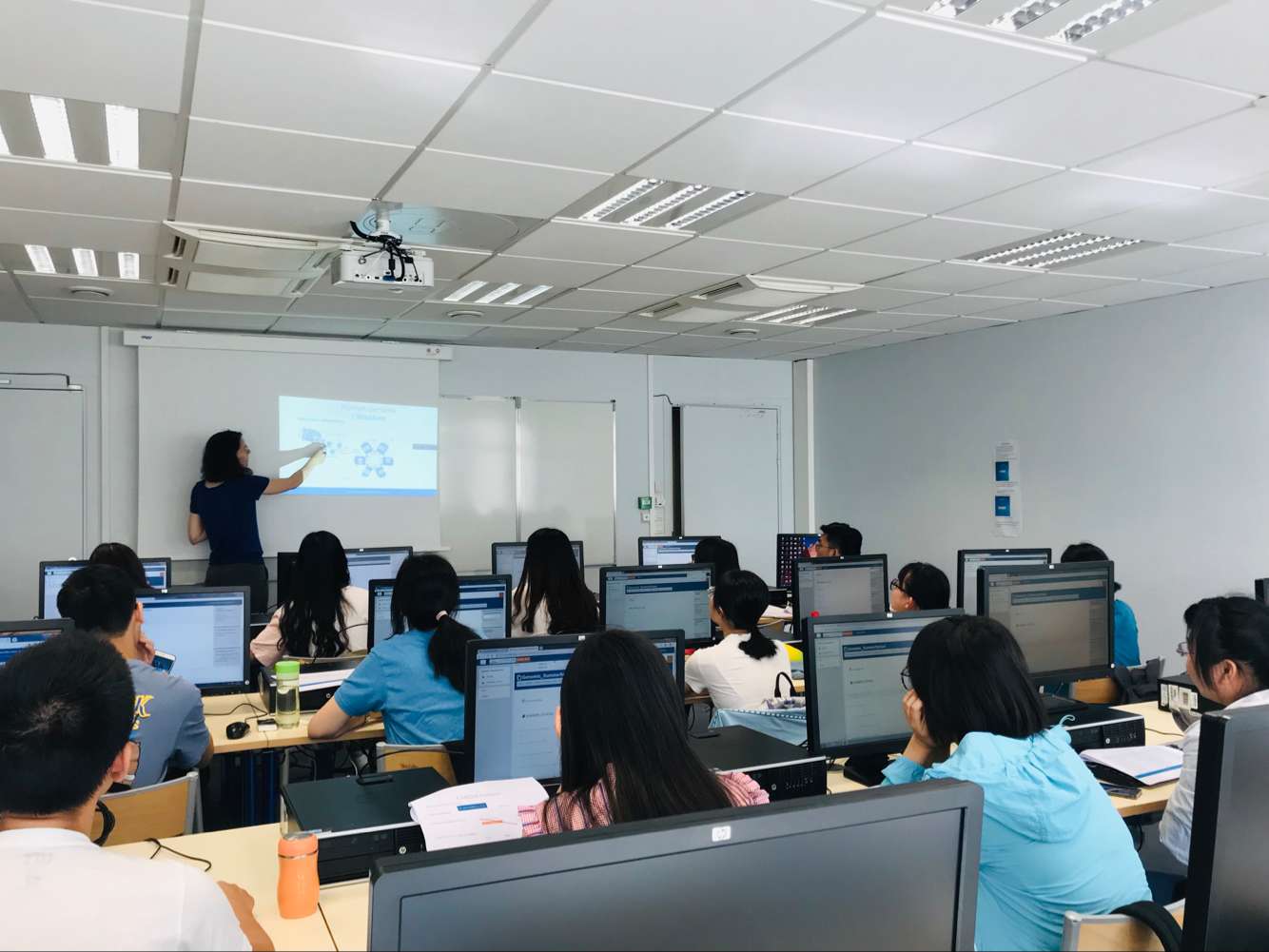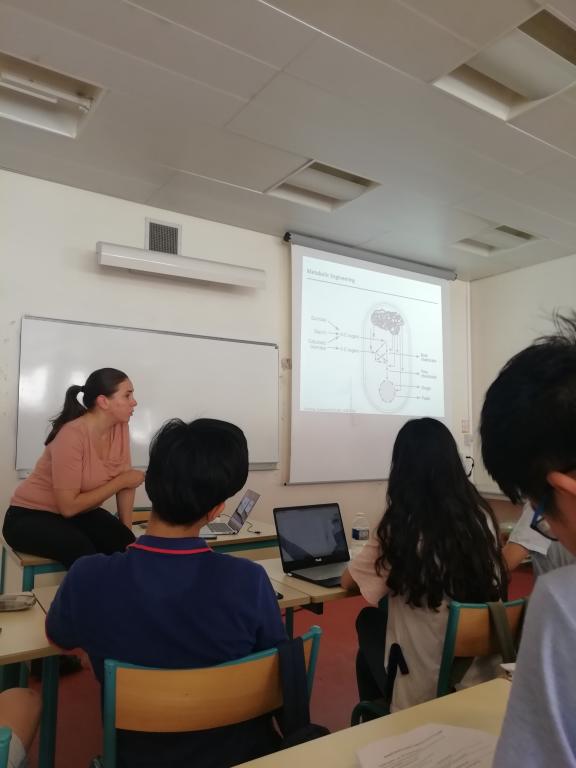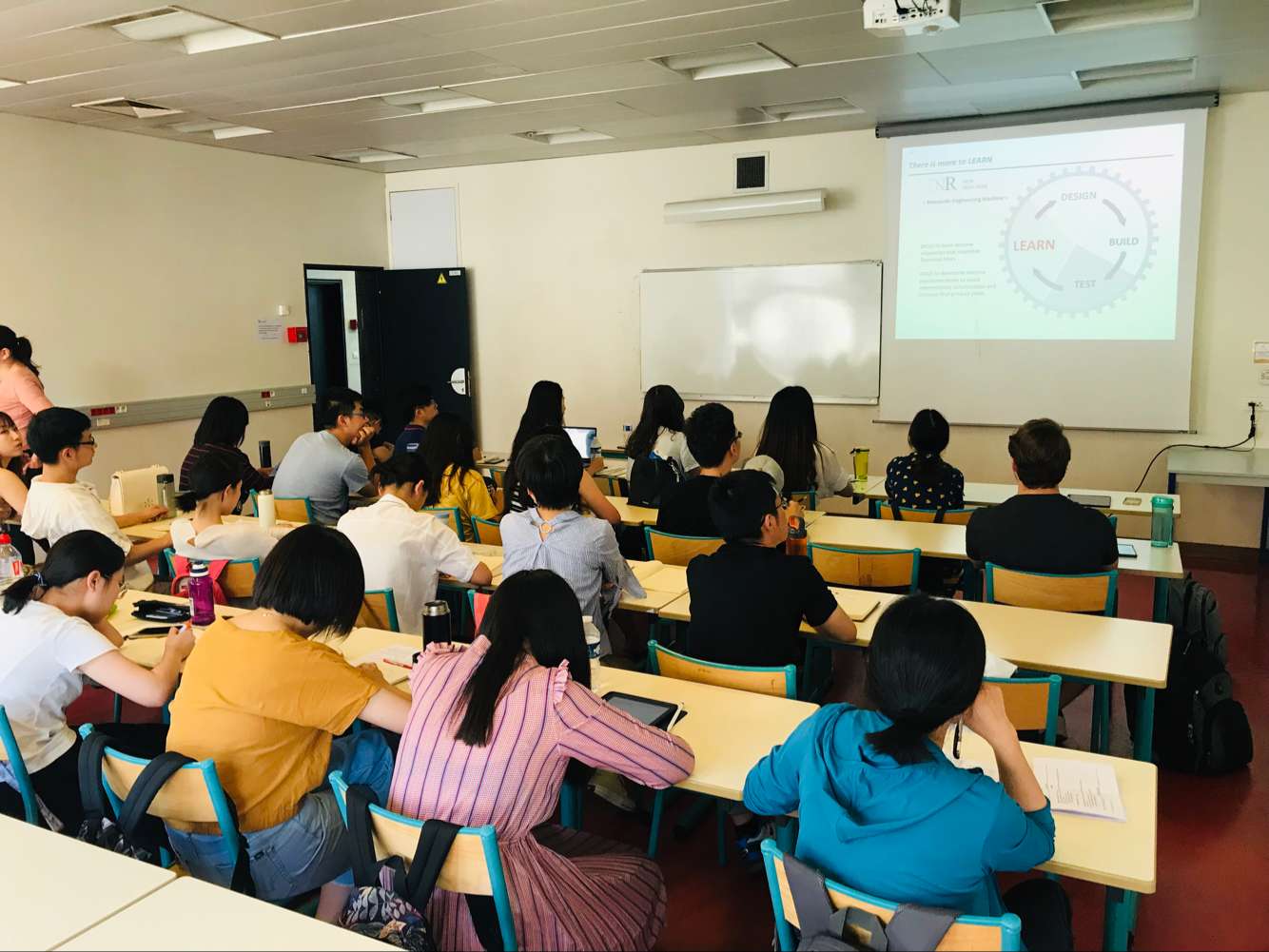法国时间7月12日,今天是在夏令营学习的第五天,今天我们前往IBGBI,在E Tei-xeira老师的指导下,学习了人类基因组学的相关知识。
基因组学是以分子生物学技术、电子计算机技术和信息网络技术为手段,以生物体内基因组的全部基因为研究对象,从整体水平上探索全基因组在生命活动的作用及其内在规律和内外环境影响机制的科学。是我们研究生命复杂系统所需的必不可少的知识基础。E Teixeira老师首先为我们介绍了DNA的结构、组成等基础知识,并详细介绍了在人生长发育过程中染色体形态的变化过程,带领我们一点点深入探索DNA的遗传奥秘。不同的染色体上存在着不同的基因,不同的染色体会组合成不同的基因型,而这些都需要精确的分配和组合,由于细胞分裂产生一些异常的基因型,这时就会导致严重的疾病。

E Teixeira老师介绍人的染色体上存在超过50%的相似序列,这些序列并不是杂乱无章的排列,而是按照一定的规则排布。基因序列的多拷贝导致重复序列的产生,即大量的无转录活性的重复DNA序列,其组织形式有两种:串联重复序列和分散重复序列。前一种成簇存在于染色体的特定区域,后一种分散于染色体的各位点上。这些序列所携带的遗传物质要实现从DNA到RNA的传递,就需要转录的过程。但是事实上并不是所有的DNA都会转录,转录形成的RNA总的来说包括编码和非编码两部分,控制着我们身体内的蛋白质的合成和身体内部的调节。
在为我们介绍了相关知识后,E Teixeira老师为我们介绍了在基因组研究中十分重要的两个数据库:NCBI和UCSC。通过老师细致的介绍,加上与之前所学过的专业课程相联系,更深入的了解了两个数据库的简单的使用方法,以及如何如何利用这两个数据库获取基因的相关信息,这对我们之后的学习研究十分有帮助。
下午,我们的课程内容是合成生物学的定义和介绍,以及一些计算机辅助代谢工程的相关介绍,由lonana POPESXU副教授讲授。合成生物学是生物学的工程,它设计和构建新的生物新功能,借鉴生物和工程的原则,以实现有益的目的。合成生物学使用了在遗传学、基因组学或分子生物学中通常没有发现的四项原理:抽象、模块化、标准化、设计和建模。合成生物学与工程、生物科学、化学和信息技术存在交集。

接着老师又向我们介绍了工程的施工和设计的基本原理和系统方法。工程是科学技术的分支,与设计、建筑和使用发动机、机器和结构有关。工程通常不被认为是科学,科学是与发现自然有关的,而工程是正在制造的、人造的。工程师们运用科学和数学的原理来解决问题。
课程还包括了一些系统生物学的部分。系统生物学研究了基础复杂的生物过程,包括许多相互作用的组件的集成系统,包括空间和动力方面。通过讲解,我们了解到,本次课程的“主角”ISSB(混合单元)在2010年创立,致力于开发生物系统工程的方法、工具和知识,并拥有两个目标:在基础方面,理解基因规则;另一方面为它们未来在生物技术(在硅和生物工具)中的使用而努力。

第二节课的内容是计算机辅助代谢工程相关。它主要是利用计算机工程等工具来辅助解决细胞代谢中的一些难题。老师还向我们介绍了两种药物的产生方式。一种是抗疟药中的青蒿素的生产,一种是1,4-丁二醇的产生。
最后lonana POPESCU副教授向我们展示了她的团队。下午的课程虽然很难,但是大家都听的很认真,学习氛围非常浓厚。
On July 12, French time, today is the fifth day of study in summer camp. Today, we went to IBGBI to learn about human genomics under the guidance of E Teixeira.
Genomics is a science that takes molecular biology technology, electronic computer technology and information network technology as its means, and takes all genes of genome in organism as its research object. It explores the role of genome in life activities, its internal law and the mechanism of internal and external environmental impact at the overall level. It is the necessary knowledge base for us to study the complex system of life. Teacher E Teixeira first introduced us the basic knowledge of DNA structure and composition, and introduced in detail the process of chromosome morphology changes during human growth and development, leading us to explore the genetic mystery of DNA bit by bit. There are different genes on different chromosomes, and different chromosomes will be combined into different genotypes. These require precise allocation and combination, as cell division produces some abnormal genotypes, which can lead to serious diseases.

Teacher E Teixeira introduced that there are more than 50% similar sequences on human chromosomes. These sequences are not disorderly, but arranged according to certain rules. Multiple copies of gene sequences lead to the production of repetitive sequences, i.e. a large number of repetitive DNA sequences without transcriptional activity, which are organized in two forms: tandem repetitive sequences and dispersed repetitive sequences. The former is clustered in a specific region of the chromosome, and the latter is scattered at each site of the chromosome. The genetic material carried by these sequences needs to be transcribed in order to transfer from DNA to RNA. But not all DNA is actually transcribed. Transcribed RNA generally includes both coding and non-coding parts, which control the synthesis of proteins in our body and the regulation of internal body.
After introducing our knowledge, Teacher E Teixeira introduced two databases that are very important in genomic research: NCBI and UCSC. Through the teacher's detailed introduction, coupled with the professional courses we have learned before, we have a deeper understanding of the simple use of the two databases, and how to use the two databases to obtain gene-related information, which is very helpful for our future study and research.
In the afternoon, our course is about the definition and introduction of synthetic biology and some related introductions of computer-aided metabolic engineering, which is taught by Professor Lonana POPESXU.Synthetic biology is a biological engineering. It designs and constructs new biological functions and draws on the principles of biology and engineering to achieve beneficial purposes. Synthetic biology uses four principles that are not usually found in genetics, genomics or molecular biology: abstraction, modularization, standardization, design and modeling. Synthetic biology intersects with engineering, bioscience, chemistry and information technology.

Then the teacher introduced to us the basic principles and system methods of the construction and design of the project. Engineering is a branch of science and technology related to design, construction and use of engines, machines and structures. Engineering is not usually regarded as science. Science is related to the discovery of nature, while engineering is being manufactured and manufactured. Engineers use the principles of science and mathematics to solve problems.
The course also includes some parts of systems biology. Systematic biology studies basic and complex biological processes, including integrated systems of many interacting components, including spatial and dynamic aspects. Through the introduction, we learned that ISSB (Mixed Unit), the protagonist of this course, was founded in 2010. It is devoted to developing the methods, tools and knowledge of biosystem engineering. It has two goals: understanding the genetic rules on the basic side and making them useful in biotechnology (in silicon and biological tools) in the future. Use and work hard.

The second lesson is about computer-aided metabolic engineering. It mainly uses computer engineering and other tools to help solve some difficult problems in cell metabolism. Teachers also introduced us to the production of two drugs. One is the production of artemisinin in antimalarial drugs and the other is the production of 1,4-butanediol.
Finally, Professor Lonana POPESCU showed us her team. The afternoon course is very difficult, but everyone listens carefully and the learning atmosphere is very strong.